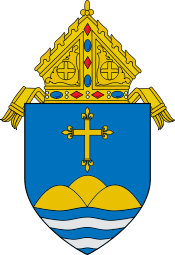Cathedral of the Holy Cross (Boston)
| Cathedral of the Holy Cross | |
|---|---|
|
North and west facades of the Cathedral of the Holy Cross in Boston, Massachusetts | |
| 42°20′26″N 71°04′10″W / 42.340693°N 71.069344°WCoordinates: 42°20′26″N 71°04′10″W / 42.340693°N 71.069344°W | |
| Location |
1400 Washington Street Boston, MA |
| Country | United States of America |
| Denomination | Roman Catholic |
| Website | www.holycrossboston.com |
| History | |
| Dedicated | December 8, 1875 |
| Architecture | |
| Status |
Cathedral (also parish church) |
| Functional status | Active |
| Architect(s) | Patrick Keely |
| Style | Gothic Revival |
| Groundbreaking | April 29, 1866 |
| Specifications | |
| Capacity | 1,700 people |
| Length | 364 feet |
| Width | 90 feet |
| Height | 120 feet |
| Materials | Roxbury puddingstone and gray limestone |
| Administration | |
| Archdiocese | Boston |
| Clergy | |
| Archbishop | Cardinal Seán Patrick O'Malley |
| Rector | Kevin J. O’LearyVF |
| Vicar(s) | Carlos Lopez |
| Deacon(s) | Ricardo M. Mesa |
| Laity | |
| Organist/Director of music | Leo D. Abbott |
The Cathedral of the Holy Cross is the cathedral of the Roman Catholic Archdiocese of Boston and is the largest Roman Catholic church in New England.[1]
When construction was finished, the cathedral rivaled both Old South Church and Trinity Church in grandeur, signalling the emergence of Roman Catholics in what was, at the time of construction, a largely Protestant city and state.
The cathedral is located in the city's South End neighborhood, at 1400 Washington St. Although the South End was initially developed for Boston's emerging Anglo-Saxon Protestant middle class, the neighborhood transitioned to new immigrants, especially Irish, as middle class owners moved to the new Back Bay neighborhood.
The cathedral functions both as a cathedral and as a parish. The Cathedral Parish consists of large English- and Spanish-speaking congregations, drawn largely from the local area, and also includes three Archdiocese-wide congregations: the Ge'ez Rite practiced by Ethiopian, Eritrean, and Egyptian Catholics; the German Apostolate; and the Tridentine Rite Catholic community. The first of these congregations moved to the cathedral from the nearby Holy Trinity Catholic Church in 1994, the other two in 2008.
History
In 1860, Bishop John Fitzpatrick recognized that the church in Boston had outgrown the old Holy Cross Cathedral on Franklin St. However, plans for the new cathedral were disrupted by the outbreak of the United States Civil War. Bishop Fitzpatrick died in 1866 and Bishop John Williams took over planning for the cathedral project. Ground was broken on April 29, 1866 and the completed structure was dedicated on December 8, 1875 by Williams, who by then, was Boston's first archbishop.[2]
Architecture
The cathedral was designed by Patrick Keely, a noted ecclesiastical architect, in the Gothic Revival style. Construction was supervised by John A. Dempwolf.[3] The building, measuring 364 ft (111 m) in length and 90 ft (27 m) at the transepts, can accommodate about 2,000 worshippers in the main level. There is also an oratory for smaller services in the lower level. It is constructed of Roxbury puddingstone with gray limestone trim and reaches a height of 120 ft (37 m). A planned western spire was never completed.[2]
The cathedral retains its E. and G.G. Hook and Hastings pipe organ, opus 801, which was installed in 1875. The organ console was replaced in 1929 with a used theatre organ console when the instrument was updated. In 2003, the Andover Organ Company created and installed its opus R-394, a replica of the original three-manual console, and updated wiring and made other needed repairs.[4][5]
Notable events
On January 19, 1964, Cardinal Cushing celebrated a Requiem for President John F. Kennedy [6] that was recorded and broadcast to the nation. The Boston Symphony Orchestra accompanied the Mozart Requiem.[7]
On October 1, 1979, Pope John Paul II held a 38-minute prayer service for 2,000 priests in the cathedral during his first pilgrimage to the United States.[8]
On April 18, 2013, an interfaith prayer vigil in honor of the victims of the Boston Marathon bombings took place at the cathedral, with President Barack Obama delivering the eulogy.[9][10]
Cathedral High School
In 1927, Cardinal William O'Connell founded Cathedral High School adjacent to the church and charged the Sisters of St. Joseph with operating the institution. The school remains at this site today.[11]
Photos
- Interior View 1
- Interior View 2
- Altar
- Hook & Hastings Pipe Organ
See also
References
- ↑ Edwin M. Bacon, Ed. (1886). Boston Illustrated. Boston: Houghton, Mifflin and Company.
- 1 2 "About". Cathedral of the Holy Cross. Retrieved July 19, 2011.
- ↑ Virtual York: An Architectural Experience: The Dempwolf Contribution to York's Streetscape
- ↑ "Holy Cross Cathedral, Boston, Massachusetts". Andover Organ Company. Retrieved July 19, 2011.
- ↑ "E. & G. G. Hook & Hastings Organ, opus 801, 1875" (PDF). American Guild of Organists. Retrieved July 19, 2011.
- ↑ http://www.thebostonpilot.com/article.asp?ID=7486
- ↑ http://www.britishpathe.com/video/kennedy-memorial-service
- ↑ Brian C. Mooney (April 3, 2005). "In Boston, America first greeted John Paul". The Boston Globe. Boston.com. Retrieved July 19, 2011.
- ↑ Angela Nelson (April 16, 2013). "Upcoming reflection services for victims of the Boston Marathon bombing". Boston.com. Retrieved April 16, 2013.
- ↑ Obama preaches ‘a state of grace’ in Boston. The Washington Post. Published: April 18, 2013.
- ↑ "About CHS". Cathedral High School. Retrieved July 19, 2011.
External links
| Wikimedia Commons has media related to Cathedral of the Holy Cross (Boston). |
- Official Cathedral Site
- Roman Catholic Archdiocese of Boston Official Site
- Keely Society
- Boston Globe Highlight
- Archdiocesan Information Page
